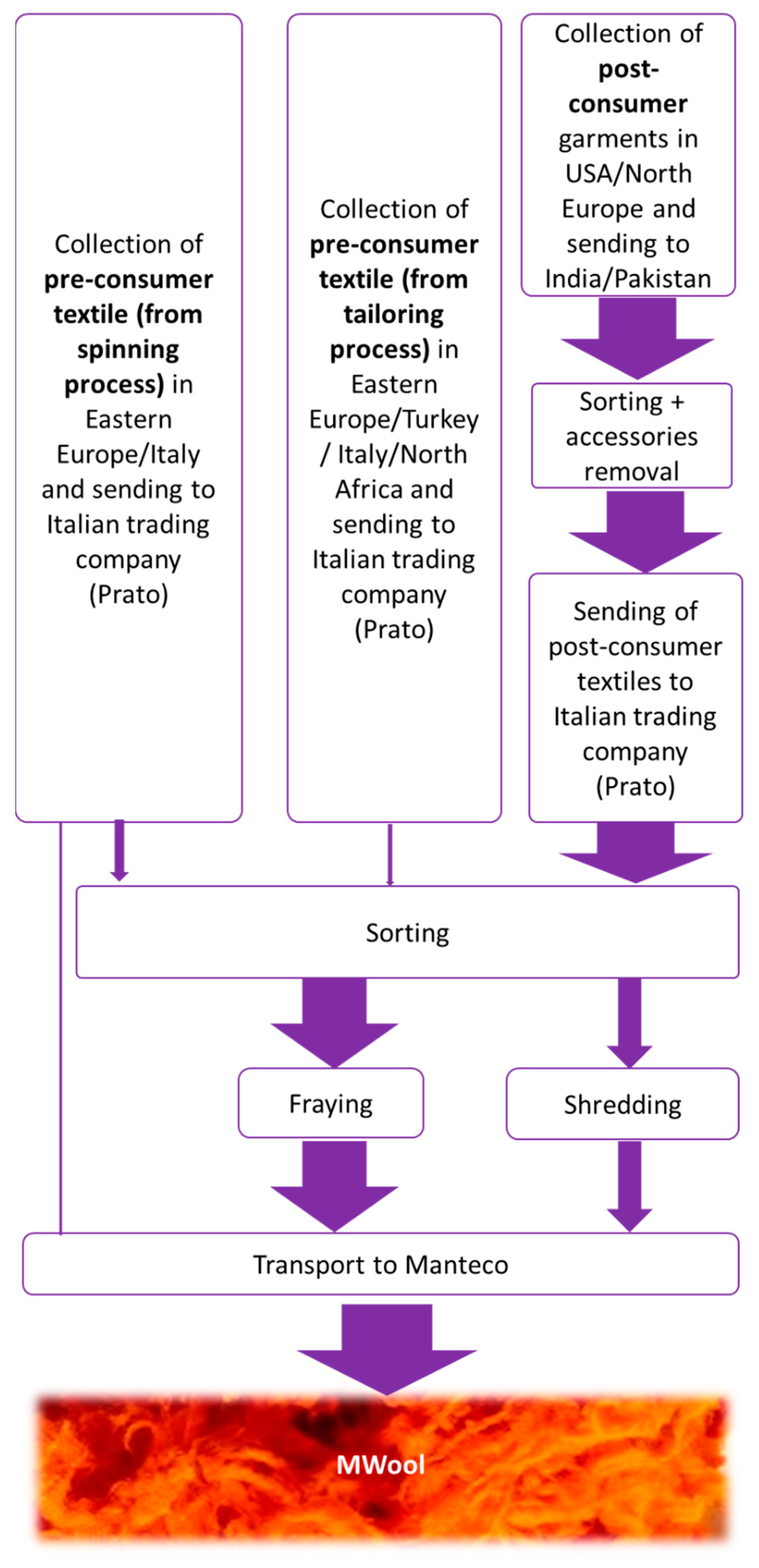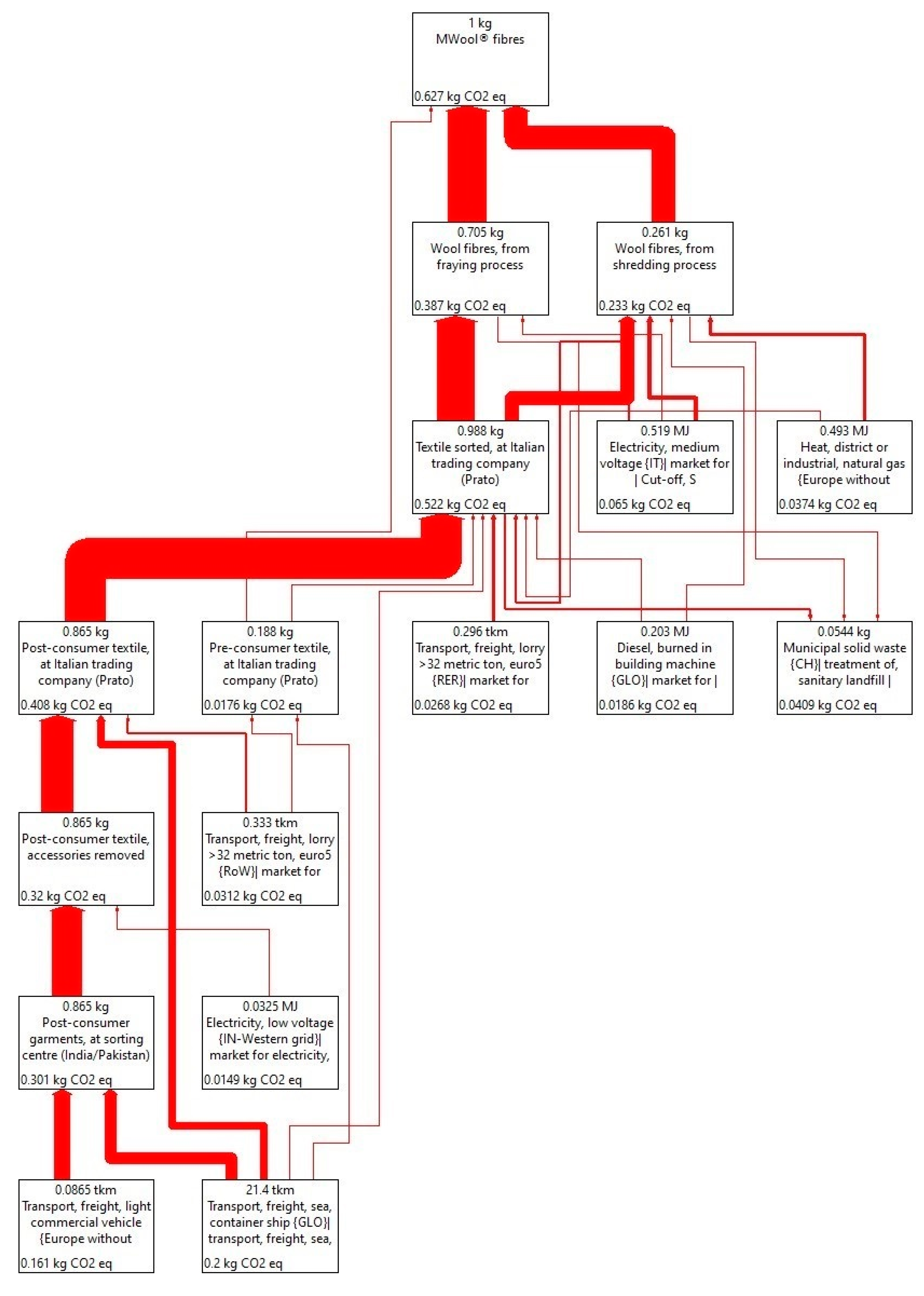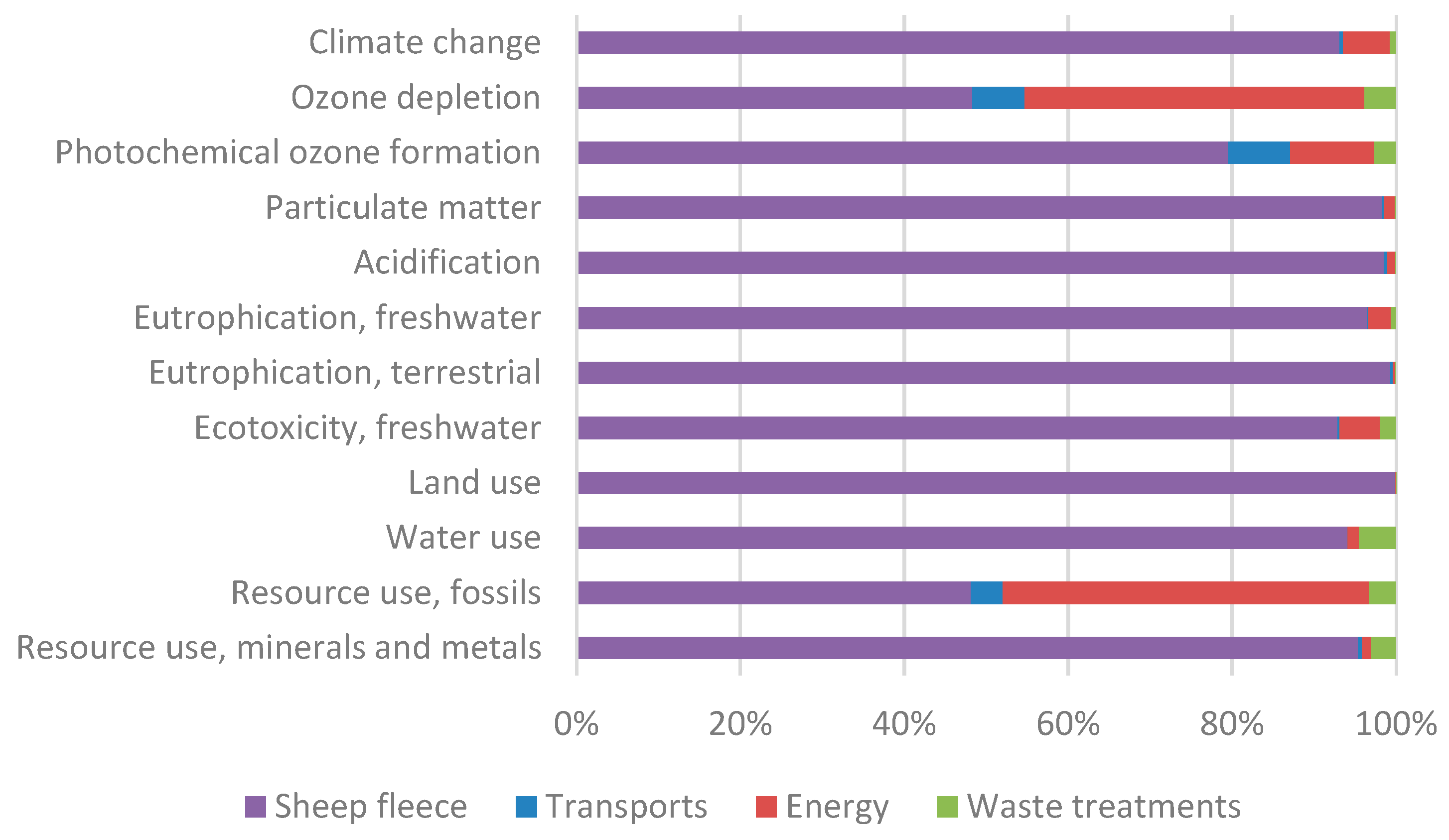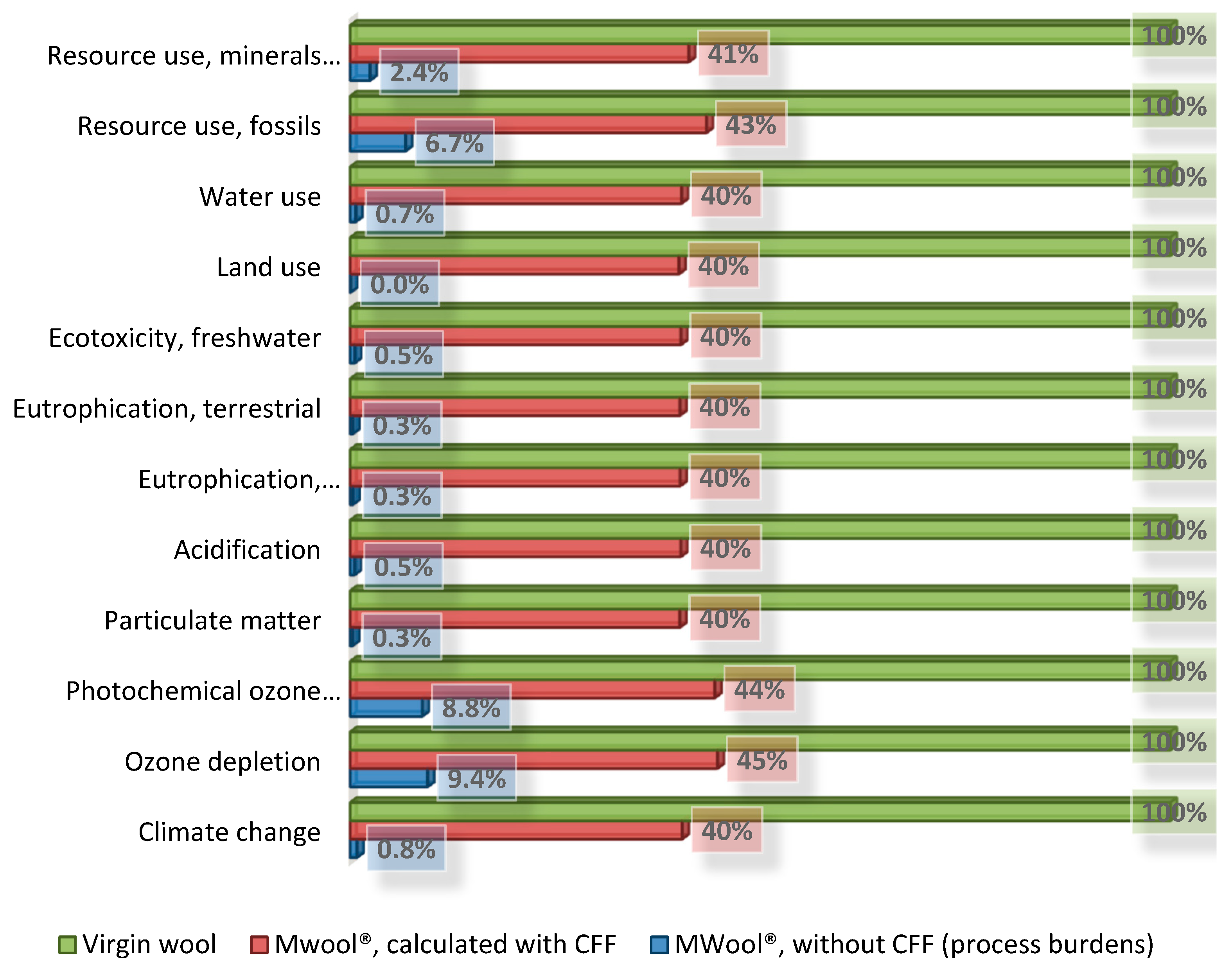Life Cycle Assessment (LCA) of MWool® Recycled Wool Fibers
Abstract
:1. Introduction
2. Materials and Methods
2.1. MWool® Supply Chain
- MWool® produced from 100% pre-consumer waste by spinning (which is not further treated)
- MWool® produced from pre-consumer waste, 100% frayed
- MWool® produced from pre-consumer waste, 100% shredded
- MWool® produced from post-consumer waste, 100% frayed
- MWool® produced from post-consumer waste, 100% shredded
- R1 is the proportion of material in the input to the production that has been recycled (equal to 1 in this case study);
- EV are the specific emissions and resources consumed arising from the acquisition and pre-processing of virgin material (virgin wool in this case study);
- A is the allocation factor of burdens and credits between supplier and user of recycled materials (equal to 0.5 in this case study, as indicated in [30]);
- Erecycled are the specific emissions and resources consumed arising from the recycling process of the recycled material (in this case study, impacts from collection of pre- and post-consumer textiles until the final the MWool® fiber);
- Qsin/Qp is the quality of the input secondary material divided by the quality of the primary material (equal to 0.8 in this case study, as indicated in [30]).
2.2. Virgin Wool Fibres’ Supply Chain
3. Results
3.1. Potential Impacts of MWool®
3.2. Potential Impacts of Virgin Wool Fibers
3.3. Comparison of MWool® and Virgin Wool Fibers
4. Discussion and Conclusions
Author Contributions
Funding
Conflicts of Interest
Appendix A
| Flow [Unit of Measure] | Quantity | Proxy in Ecoinvent |
|---|---|---|
| Output | ||
| Post-consumer garments, at sorting centre (India/Pakistan) [t] | 1 | - |
| Inputs | ||
| Plastic bags [kg] | 1.6 | Packaging film, low-density polyethylene {GLO}| market for|Cut-off, S |
| Transport with small lorry [tkm] 1 | 100 | Transport, freight, light commercial vehicle {Europe without Switzerland}|market for transport, freight, light commercial vehicle|Cut-off, S |
| Electricity in USA [kWh] | 2.6 | Electricity, medium voltage {US}|market group for|Cut-off, S |
| Electricity in North Europe [kWh] | 2.6 | Electricity, medium voltage {NL}|market for|Cut-off, S |
| Big bales [kg] | 1.1 | Polyethylene, high density, granulate {GLO}|market for|Cut-off, S + Extrusion, plastic film {GLO}|market for|Cut-off, S |
| Transport with 16–32 t lorry [tkm] 2 | 92 | Transport, freight, lorry 16–32 metric ton, euro5 {RoW}|market for transport, freight, lorry 16–32 metric ton, EURO5|Cut-off, S |
| Transport with transoceanic ship [tkm] 2 | 14,798 | Transport, freight, sea, container ship {GLO}|transport, freight, sea, container ship|Cut-off, S |
| Waste: plastic [kg] | 2.7 | Waste plastic, mixture {RoW}|treatment of waste plastic, mixture, municipal incineration|Cut-off, S |
| Flow [Unit of Measure] | Quantity | Proxy in Ecoinvent |
|---|---|---|
| Output | ||
| Post-consumer textile, accessories removed, transported to Italy [t] | 1 | - |
| Inputs | ||
| Post-consumer garments, at sorting centre [t] | 1 | |
| Electricity in Pakistan [kWh] | 1.84 | Electricity, low voltage {PK}|market for electricity, low voltage|Cut-off, S |
| Electricity in India [kWh] | 10.4 | Electricity, low voltage {IN-Western grid}|market for electricity, low voltage|Cut-off, S |
| Big bales [kg] | 1.1 | Polyethylene, high density, granulate {GLO}|market for|Cut-off, S + Extrusion, plastic film {GLO}|market for|Cut-off, S |
| Transport with >32 t lorry [tkm] 1 | 201 | Transport, freight, lorry > 32 metric ton, euro5 {RoW}|market for transport, freight, lorry > 32 metric ton, EURO5|Cut-off, S |
| Transport with transoceanic ship [tkm] 1 | 8837 | Transport, freight, sea, container ship {GLO}|transport, freight, sea, container ship|Cut-off, S |
| Flow [Unit of Measure] | Quantity | Proxy in Ecoinvent |
|---|---|---|
| Output | ||
| Pre-consumer textile, at Italian trading company (Prato) [t] | 1 | - |
| Inputs | ||
| Pre-consumer textile [t] | 1 | |
| Big bales [kg] | 1.1 | Polyethylene, high density, granulate {GLO}|market for|Cut-off, S + Extrusion, plastic film {GLO}|market for|Cut-off, S |
| Transport with >32 t lorry [tkm] 1 | 848 | Transport, freight, lorry > 32 metric ton, euro5 {RoW}|market for transport, freight, lorry > 32 metric ton, EURO5|Cut-off, S |
| Transport with transoceanic ship [tkm] 1 | 1144 | Transport, freight, sea, container ship {GLO}|transport, freight, sea, container ship|Cut-off, S |
| Flow [Unit of Measure] | Quantity | Proxy in Ecoinvent |
|---|---|---|
| Output | ||
| Textile sorted, at Italian trading company (Prato) [t] | 1 | - |
| Inputs | ||
| Post-consumer textile, at Italian trading company (Prato) [t] | 1.03 × 0.85 = 0.876 | |
| Pre-consumer textile, at Italian trading company (Prato) [t] | 1.03 × 0.15 = 0.155 | |
| Electricity [kWh] | 42.11 | Electricity, medium voltage {IT}|market for|Cut-off, S |
| Natural gas [MJ] | 42 | Heat, district or industrial, natural gas {Europe without Switzerland}|heat production, natural gas, at industrial furnace low-NOx > 100 kW|Cut-off, S |
| Diesel [MJ] | 168 | Diesel, burned in building machine {GLO}|market for|Cut-off, S |
| Water [m3] | 0,27 | Tap water {RER}|market group for|Cut-off, S |
| Transport with >32 t lorry [tkm] | 300 | Transport, freight, lorry > 32 metric ton, euro5 {RER}|market for transport, freight, lorry > 32 metric ton, EURO5|Cut-off, S |
| Transport with transoceanic ship [tkm] | 10,000 | Transport, freight, sea, container ship {GLO}|transport, freight, sea, container ship|Cut-off, S |
| Waste: plastic [kg] | 1.1 | Waste plastic, mixture {CH}|treatment of, municipal incineration|Cut-off, S |
| Waste: textile [kg] | 32 | Municipal solid waste {CH}|treatment of, sanitary landfill|Cut-off, S |
| Flow [Unit of Measure] | Quantity | Proxy in Ecoinvent |
|---|---|---|
| Output | ||
| Wool fibres, from shredding process [t] | 1 | - |
| Inputs | ||
| Textile sorted, at Italian trading company [t] | 1.03 | |
| Electricity [kWh] | 391 | Electricity, medium voltage {IT}|market for|Cut-off, S |
| Natural gas [MJ] | 1729 | Heat, district or industrial, natural gas {Europe without Switzerland}| heat production, natural gas, at industrial furnace low-NOx > 100 kW|Cut-off, S |
| Diesel [MJ] | 141 | Diesel, burned in building machine {GLO}|market for|Cut-off, S |
| Water [m3] | 1.33 | Tap water {RER}| market group for|Cut-off, S |
| No foam agent | 3.83 | Silicone product {RER}| market for silicone product|Cut-off, S |
| Transport with >32 t lorry [tkm] | 300 | Transport, freight, lorry > 32 metric ton, euro5 {RER}|market for transport, freight, lorry > 32 metric ton, EURO5|Cut-off, S |
| Transport with transoceanic ship [tkm] | 10,000 | Transport, freight, sea, container ship {GLO}|transport, freight, sea, container ship|Cut-off, S |
| Waste: plastic [kg] | 1.1 | Waste plastic, mixture {CH}|treatment of, municipal incineration|Cut-off, S |
| Waste: textile [kg] | 32 | Municipal solid waste {CH}|treatment of, sanitary landfill|Cut-off, S |
| Flow [Unit of Measure] | Quantity | Proxy in Ecoinvent |
|---|---|---|
| Output | ||
| Wool fibres, from faying process [t] | 1 | - |
| Inputs | ||
| Textile sorted, at Italian trading company [t] | 1.02 | |
| Electricity [kWh] | 0.19 | Electricity, medium voltage {IT}|market for|Cut-off, S |
| Transport with lorry [tkm] | 20 | Transport, freight, lorry 7.5–16 metric ton, euro5 {RER}|market for transport, freight, lorry 7.5–16 metric ton, EURO5|Cut-off, S |
| Waste: iron [kg] | 7.09 | Iron scrap, sorted, pressed {RER}|sorting and pressing of iron scrap|Cut-off, S + Avoided product: Pig iron {RoW}|pig iron production|Cut-off, S |
| Waste: textile [kg] | 22.83 | Municipal solid waste {CH}|treatment of, sanitary landfill|Cut-off, S |
| Flow [Unit of Measure] | Quantity | Proxy in Ecoinvent |
|---|---|---|
| Output | ||
| Wastewater treated [m3] | 1 | - |
| Inputs | ||
| Wastewater [m3] | 1 | |
| Electricity [kWh] | 0.699 | Electricity, medium voltage {IT}|market for|Cut-off, S |
| Natural gas [Sm3] | 0.041 | Heat, district or industrial, natural gas {Europe without Switzerland}| heat production, natural gas, at industrial furnace low-NOx > 100 kW|Cut-off, S |
| Diesel [MJ] | 0.098 | Diesel, burned in building machine {GLO}|market for|Cut-off, S |
| Gasoline [MJ] | 0.0017 | Petrol, unleaded, burned in machinery {GLO}|market for petrol, unleaded, burned in machinery|Cut-off, S |
| LPG [MJ] | 0.00032 | Heat, central or small-scale, natural gas {GLO}|propane extraction, from liquefied petroleum gas|Cut-off, S |
| Aluminium trichloride [g] | 25.60 | Aluminium chloride {GLO}|market for aluminium chloride|Cut-off, S |
| Citric acid [g] | 0.33 | Citric acid {RER}|production|Cut-off, S |
| Sulfuric acid 50% [g] | 0.43 | Sulfuric acid {RER}| market for sulfuric acid|Cut-off, S + Tap water {RER}|market group for|Cut-off, S |
| Sulfuric acid 96% [g] | 0.07 | Sulfuric acid {RER}|market for sulfuric acid|Cut-off, S + Tap water {RER}|market group for|Cut-off, S |
| Hydrogen peroxide [g] | 0.25 | Hydrogen peroxide, without water, in 50% solution state {RER}| hydrogen peroxide production, product in 50% solution state|Cut-off, S + Tap water {RER}|market group for|Cut-off, S |
| No foam agent [g] | 1.13 | Silicone product {RER}|market for silicone product|Cut-off, S |
| Ferric chloride [g] | 24.60 | Iron (III) chloride, without water, in 40% solution state {GLO}|market for|Cut-off, S |
| Bleaching agent [g] | 5.71 | Sodium dithionite, anhydrous {RER}|market for sodium dithionite, anhydrous|Cut-off, S |
| Sodium hydroxide 50% [g] | 1.57 | Sodium hydroxide, without water, in 50% solution state {GLO}|market for|Cut-off, S + Tap water {RER}|market group for|Cut-off, S |
| Sodium hypochlorite 15% [g] | 2.37 | Sodium hypochlorite, without water, in 15% solution state {RER}|market for sodium hypochlorite, without water, in 15% solution state|Cut-off, S + Tap water {RER}|market group for|Cut-off, S |
| Oxygen [g] | 0.12 | Oxygen, liquid {RER}|market for|Cut-off, S |
| Anionic polyelectrolyte [g] | 1.34 | Polyacrylamide {GLO}|market for|Cut-off, S |
| Cationic polyelectrolyte [g] | 5.03 | Polyacrylamide {GLO}|market for|Cut-off, S |
| Urea [g] | 0.05 | Urea {RER}|market for urea|Cut-off, S |
References
- Beton, A.; Dias, D.; Farrant, L.; Gibon, T.; Le Guern, Y.; Desaxce, M.; Perwueltz, A.; Boufateh, I.; Wolf, O.; Kougoulis, I.; et al. Environmental Improvement Potential of Textiles (IMPRO Textiles); Publications Office of the European Union: Luxembourg, 2014. [Google Scholar]
- Manshoven, S.; Christis, M.; Vercalsteren, A.; Arnold, M.; Nicolau, M.; Lafond, E.; Mortensen, L.; Coscieme, L. Textiles and the Environment in a Circular Economy; European Environmental Agency: Mol, Belgium, 2019. [Google Scholar]
- European Commission. Delivering the European Green Deal; European Commission: Brussels, Belgium, 2021. [Google Scholar]
- European Commission. A New Circular Economy Action Plan for a Cleaner and More Competitive Europe; European Commission: Brussels, Belgium, 2020. [Google Scholar]
- European Commission. A New Industrial Strategy for Europe; COM 102 Final; European Commission: Brussels, Belgium, 2020. [Google Scholar]
- EN ISO 14040:2006; Valutazione del Ciclo di vita Principi e Quadro di Riferimento. International Standards Organization: Geneva, Switzerland, 2006.
- ISO 14044: 2006; The International Standards Organisation Environmental Management—Life Cycle Assessment—Requirements and Guidelines. International Standards Organization: Geneva, Switzerland, 2006; Volume 2006, pp. 652–668. [CrossRef]
- Wolf, M.-A.; Chomkhamsri, K.; Brandao, M.; Pant, R.; Ardente, F.; Pennington, D.W.; Manfredi, S.; de Camillis, C.; Goralczyk, M. ILCD Handbook—General Guide for Life Cycle Assessment—Detailed Guidance, 1st ed.; Via E. Fermi: Ispra, Italy, 2010. [Google Scholar]
- Manfredi, S.; Allacker, K.; Pelletier, N.; Chomkhamsri, K.; de Souza, D.M. Product Environmental Footprint (PEF) Guide; European Commission Joint Research Centre: Ispra, Italy, 2012. [Google Scholar]
- Barber, A.; Pellow, G. LCA: New Zealand merino wool total energy use. In Proceedings of the 5th Australian Life Cycle Assessment Society (ALCAS) Conference, Melbourne, Australia, 22–24 November 2006; pp. 22–24. [Google Scholar]
- Bech, N.M.; Birkved, M.; Charnley, F.; Laumann Kjaer, L.; Pigosso, D.C.A.; Hauschild, M.Z.; McAloone, T.C.; Moreno, M. Evaluating the Environmental Performance of a Product/Service-System Business Model for Merino Wool Next-to-Skin Garments: The Case of Armadillo Merino®. Sustainability 2019, 11, 5854. [Google Scholar] [CrossRef] [Green Version]
- Wiedemann, S.; Ledgard, S.; Henry, B.K.; Yan, M.-J.; Mao, N.; Russell, S. Application of life cycle assessment to sheep production systems: Investigating co-production of wool and meat using case studies from major global producers. Int. J. Life Cycle Assess. 2015, 20, 463–476. [Google Scholar] [CrossRef] [Green Version]
- Wiedemann, S.G.; Yan, M.-J.; Henry, B.K.; Murphy, C.M. Resource use and greenhouse gas emissions from three wool production regions in Australia. J. Clean. Prod. 2016, 122, 121–132. [Google Scholar] [CrossRef] [Green Version]
- Dahlbo, H.; Aalto, K.; Eskelinen, H.; Salmenperä, H. Increasing textile circulation—Consequences and requirements. Sustain. Prod. Consum. 2017, 9, 44–57. [Google Scholar] [CrossRef]
- Spathas, T. The Environmental Performance of High Value Recycling for the Fashion Industry. Master’s Thesis, Chalmers University of Technology, Gothenburg, Sweden, 2017. [Google Scholar]
- Wiedemann, S.G.; Biggs, L.; Clarke, S.J.; Russell, S.J. Reducing the Environmental Impacts of Garments through Industrially Scalable Closed-Loop Recycling: Life Cycle Assessment of a Recycled Wool Blend Sweater. Sustainability 2022, 14, 1081. [Google Scholar] [CrossRef]
- Watson, K.J.; Wiedemann, S.G. Review of Methodological Choices in LCA-Based Textile and Apparel Rating Tools: Key Issues and Recommendations Relating to Assessment of Fabrics Made From Natural Fibre Types. Sustainability 2019, 11, 3846. [Google Scholar] [CrossRef] [Green Version]
- Sandin, G.; Peters, G.M. Environmental impact of textile reuse and recycling—A review. J. Clean. Prod. 2018, 184, 353–365. [Google Scholar] [CrossRef]
- Wiedemann, S.G.; Biggs, L.; Nebel, B.; Bauch, K.; Laitala, K.; Klepp, I.G.; Swan, P.G.; Watson, K. Environmental impacts associated with the production, use, and end-of-life of a woollen garment. Int. J. Life Cycle Assess 2020, 25, 1486–1499. [Google Scholar] [CrossRef]
- Eady, S.; Carre, A.; Grant, T. Life cycle assessment modelling of complex agricultural systems with multiple food and fibre co-products. J. Clean. Prod. 2012, 28, 143–149. [Google Scholar] [CrossRef]
- Dougherty, H.C. Mechanistic Modeling & Life Cycle Assessment of Environmental Impacts of Beef Cattle & Sheep Production; University of California: Davis, CA, USA, 2018; ISBN 0355967944. [Google Scholar]
- Brock, P.M.; Graham, P.; Madden, P.; Alcock, D.J. Greenhouse gas emissions profile for 1 kg of wool produced in the Yass Region, New South Wales: A Life Cycle Assessment approach. Anim. Prod. Sci. 2013, 53, 495–508. [Google Scholar] [CrossRef]
- Biswas, W.K.; Graham, J.; Kelly, K.; John, M.B. Global warming contributions from wheat, sheep meat and wool production in Victoria, Australia—A life cycle assessment. J. Clean. Prod. 2010, 18, 1386–1392. [Google Scholar] [CrossRef]
- Köhler, A.; Watson, D.; Trzepacz, S.; Löw, C.; Liu, R.; Danneck, J.; Konstantas, A.; Donatello, S.; Faraca, G. Circular Economy Perspectives in the EU Textile Sector; Publications Office of the European Union: Luxembourg, 2021; ISBN 9276386467. [Google Scholar]
- Lindström, K.; Sjöblom, T.; Persson, A.; Kadi, N. Improving Mechanical Textile Recycling by Lubricant Pre-Treatment to Mitigate Length Loss of Fibers. Sustainability 2020, 12, 8706. [Google Scholar] [CrossRef]
- Roos, S.; Sandin, G.; Peters, G.; Spak, B.; Schwarz Bour, L.; Perzon, E.; Jönsson, C. White Paper on Textile Recycling. Mistra Future Fashion Mölndal (Mistra Future Fashion report number: 2019:09). 2020, Volume 2. Available online: http//mistrafuturefashion.com/wpcontent/uploads/2019/10/S.-Roos.-White-paper-on-textile-recycling.-Mistra-Future-Fashion.pdf (accessed on 25 February 2022).
- European Commission. Commission Recommendation on the Use of the Environmental Footprint Methods to Measure and Communicate the Life Cycle Environmental Performance of Products and Organisations; European Commission: Brussels, Belgium, 2021. [Google Scholar]
- Schrijvers, D.L.; Loubet, P.; Weidema, B.P. To what extent is the Circular Footprint Formula of the Product Environmental Footprint Guide consequential? J. Clean. Prod. 2021, 320, 128800. [Google Scholar] [CrossRef]
- Pedersen, E.; Remmen, A. Challenges with product environmental footprint: A systematic review. Int. J. Life Cycle Assess 2022, 27, 342–352. [Google Scholar] [CrossRef]
- Confindustria Toscana Nord. Schema Nazionale Volontario “Made Green in Italy”. In Regole di Categoria di Prodotto (RCP): Tessuti in lana Cardata o Peli Fini Cardati; Confindustria Toscana Nord: Pistoia, Italy, 2021; p. 40. [Google Scholar]
- Testa, F.; Nucci, B.; Iraldo, F.; Appolloni, A.; Daddi, T. Removing obstacles to the implementation of LCA among SMEs: A collective strategy for exploiting recycled wool. J. Clean. Prod. 2017, 156, 923–931. [Google Scholar] [CrossRef]
- Fazio, S.; Biganzoli, F.; De Laurentiis, V.; Zampori, L.; Sala, S.; Diaconu, E. Supporting Information to the Characterisation Factors of Recommended EF Life Cycle Impact Assessment Methods; Publications Office of the European Union: Luxembourg, 2018. [Google Scholar] [CrossRef]
- Şerbănel, C. Romanian textile industry and its competitive advantage. SEA–Pract. Appl. Sci. 2014, 2, 395–404. [Google Scholar]
- Kashiwagi, K.; Iwasaki, E. Effect of agglomeration on technical efficiency of small and medium-sized garment firms in Egypt. Afr. Dev. Rev. 2020, 32, 14–26. [Google Scholar] [CrossRef]
- Humpston, G.; Willis, P.; Tyler, D.; Han, S. Technologies for Sorting End of Life Textiles; Waste and Resources Action Programme: Oxon, UK, 2014. [Google Scholar]
- Bhatt, A.; Abbassi, B. Review of environmental performance of sheep farming using life cycle assessment. J. Clean. Prod. 2021, 293, 126192. [Google Scholar] [CrossRef]







| Impact Category | Unit | MWool® |
|---|---|---|
| Climate change | kg CO2 eq | 6.27 × 10−1 |
| Ozone depletion | kg CFC11 eq | 1.10 × 10−7 |
| Photochemical ozone formation | kg NMVOC eq | 6.41 × 10−3 |
| Particulate matter | disease inc. | 3.47 × 10−8 |
| Acidification | mol H+ eq | 8.30 × 10−3 |
| Eutrophication, freshwater | kg P eq | 6.24 × 10−5 |
| Eutrophication, terrestrial | mol N eq | 2.37 × 10−2 |
| Eco-toxicity, freshwater | CTUe | 6.31 |
| Land use | Pt | 2.95 |
| Water use | m3 depriv. | 9.30 × 10−2 |
| Resource use, fossils | MJ | 8.39 |
| Resource use, minerals and metals | kg Sb eq | 3.32 × 10−3 |
| Impact Category | Unit | Virgin Wool Fibers |
|---|---|---|
| Climate change | kg CO2 eq | 7.58 × 10 |
| Ozone depletion | kg CFC11 eq | 1.17 × 10−6 |
| Photochemical ozone formation | kg NMVOC eq | 7.31 × 10−2 |
| Particulate matter | disease inc. | 1.19 × 10−5 |
| Acidification | mol H+ eq | 1.69 |
| Eutrophication, freshwater | kg P eq | 1.83 × 10−2 |
| Eutrophication, terrestrial | mol N eq | 7.43 |
| Eco-toxicity, freshwater | CTUe | 1.20 × 103 |
| Land use | Pt | 7.74 × 103 |
| Water use | m3 depriv. | 1.39 × 101 |
| Resource use, fossils | MJ | 1.25 × 102 |
| Resource use, minerals and metals | kg Sb eq | 1.38 × 10−4 |
| Virgin Wool | MWool® (with CFF) | |
|---|---|---|
| MIN (kg CO2 eq./kg) | 19.8 | 8.2 |
| MAX (kg CO2 eq./kg) | 103.0 | 41.5 |
Publisher’s Note: MDPI stays neutral with regard to jurisdictional claims in published maps and institutional affiliations. |
© 2022 by the authors. Licensee MDPI, Basel, Switzerland. This article is an open access article distributed under the terms and conditions of the Creative Commons Attribution (CC BY) license (https://creativecommons.org/licenses/by/4.0/).
Share and Cite
Bianco, I.; Gerboni, R.; Picerno, G.; Blengini, G.A. Life Cycle Assessment (LCA) of MWool® Recycled Wool Fibers. Resources 2022, 11, 41. https://doi.org/10.3390/resources11050041
Bianco I, Gerboni R, Picerno G, Blengini GA. Life Cycle Assessment (LCA) of MWool® Recycled Wool Fibers. Resources. 2022; 11(5):41. https://doi.org/10.3390/resources11050041
Chicago/Turabian StyleBianco, Isabella, Raffaella Gerboni, Giuseppe Picerno, and Gian Andrea Blengini. 2022. "Life Cycle Assessment (LCA) of MWool® Recycled Wool Fibers" Resources 11, no. 5: 41. https://doi.org/10.3390/resources11050041
APA StyleBianco, I., Gerboni, R., Picerno, G., & Blengini, G. A. (2022). Life Cycle Assessment (LCA) of MWool® Recycled Wool Fibers. Resources, 11(5), 41. https://doi.org/10.3390/resources11050041





